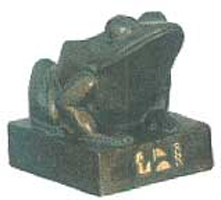Heqet (Heket) was a goddess of childbirth, creation and grain germination. She was depicted as a frog, or a woman with the head of a frog, betraying her connection with water. As a water goddess, she was also a goddess of fertility where she was particularly associated with the later stages of labour. In this way, the title of “Servants of Heqet” may have been a title applied to her priestesses who were trained as midwives. The ancient Egyptians saw thousands of frogs appear all along the Nile at certain times of the year. This appearance of the reptile came to symbolise fruitfulness and coming life.
 She was thought to be the wife of Khnum, the god who creates men on his potter’s wheel, and she gave the newly created being the breath of life before the child was placed to grow in the mother’s womb. In the story of the triplets who would be pharaohs, she was the goddess of magically “hastens the birth”, in an unspecified manner. In Hatshepsut’s birth colonnade, it is Heqet, with Khnum, who led Ahmose to the birthing room. She also was depicted as the goddess who held the ankh sign of life to Hatshepsut and her ka, fulfilling her job as the giver of life to the newly created child. She originally appears in the pyramid texts where she helps the pharaoh ascend into the sky.
She was thought to be the wife of Khnum, the god who creates men on his potter’s wheel, and she gave the newly created being the breath of life before the child was placed to grow in the mother’s womb. In the story of the triplets who would be pharaohs, she was the goddess of magically “hastens the birth”, in an unspecified manner. In Hatshepsut’s birth colonnade, it is Heqet, with Khnum, who led Ahmose to the birthing room. She also was depicted as the goddess who held the ankh sign of life to Hatshepsut and her ka, fulfilling her job as the giver of life to the newly created child. She originally appears in the pyramid texts where she helps the pharaoh ascend into the sky.
Osiris, ithyphallic and bearded, in mummied form, lying upon his bier; over his feet and his body hover the hawks. At the head kneels Hathor, “Mistress of Amentet, who weepeth for ‘her brother’,” and at the foot is a frog symbol of the goddess Heqet, beneath the bier are an ibis-headed god holding the Utchat, two serpents, and the god Bes. As such, she was not only a goddess of birth, but of rebirth, because of her life-giving powers. Amulets of Heqet were worn by women to protect them while they gave birth. During the Middle Kingdom ritual ivory knives and clappers (a type of percussional musical instrument) bore her name or image as protection for inside the home. There was a Ptolemaic temple to Heqet at Qus, of which only a pylon remains. She was also known as “Lady of Her-wer”: A tomb at Tuna el-Gebel has text speaks about a procession in her honour where she asks that the temple of Heqet at Her-wer be restored and protected from inundation, but this temple has not been found, yet.